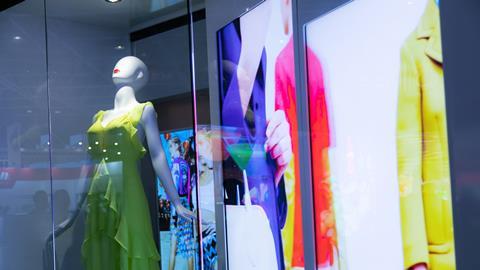Integrating new technologies and types of digital signage in store is essential for competing with other retailers, says Integrated Systems Europe (ISE).
Digital signage was once seen as a way of redressing the competitive balance between online and high street retailers.
Now, as retailers have recognised how technology can improve customer engagement – leading it to become integral to store design – digital signage has moved to a second phase: to establish competitive advantage over other retailers.
“Smart retailers can harness technology to deliver a unique customer experience”
Laila Hede Jensen, Digital Signage Organisation
“Smart retailers can harness technology to deliver a unique customer experience,” says Laila Hede Jensen, board member of the Digital Signage Organisation.
“Augmented reality, artificial intelligence and facial recognition may not yet be standard on the high street, but the data-driven benefits provided will make retailers take note.
“This is a true example of a value-added service, providing the consumer with a quicker, more personalised retail experience.”
The current trend is for integrating signage into other in-store technologies, creating a digital strategy within bricks and mortar to deliver highly personalised experiences.
“Consumers expect more than just functional stores,” says Florian Rotberg, managing director of digital signage researcher and consultancy Invidis and chairman of the Digital Signage Summit ISE 2020, which takes place in Amsterdam next month.
“Retail experiences are becoming more important, and digital plays an integral role in delivering personalised, ever-surprising experiences at the point of sale.
“In addition, cross-channel shopping is becoming the new norm, meaning that retailers need to offer seamless user experiences – which is only possible with digital touchpoints and back-end integration.
“Displays need to be positioned along the customer journey where they add value – not where the retailer has space left”
Florian Rotberg, Invidis
“Screens have long been the face of digital signage, but recent important developments include the replacement of the ubiquitous LCD screen with direct-view and very-fine-pitch LED screens.
“Digital without appearing digital is one of the important trends, where it enables data-driven experiences in which the consumer is not necessarily confronted with a phalanx of screens,” says Rotberg.
“Displays need to be positioned along the customer journey where they add value – not where the retailer has some space left.”
Find out more about these transformative technologies at ISE – the world’s largest audiovisual exhibition – which opens its doors in Amsterdam on February 11, 2020.
For many in the industry, it is seen as a must-attend event – not least because ISE is not ‘just’ a digital signage show, but an opportunity to evaluate numerous technologies and products that are no less applicable to the retail environment.
The event also features the Digital Signage Summit ISE – a half-day strategy conference co-organised by Invidis, taking place on February 12, 2020, at Hotel Okura Amsterdam.
Attendees can benefit from more than 1,300 exhibitors at ISE 2020, with a dedicated hall covering digital signage and digital out-of-home advertising.






























